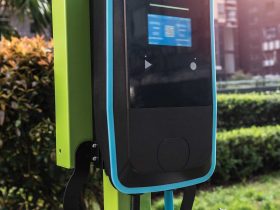After a well-known fiasco of the 1990s, electric vehicles are making a rapid and confident comeback.
They are here to stay and to change our lives. Are we ready for them?
Let’s take a look.
Section 86 of the 2009 edition of the Canadian Electrical Code has been revised to clarify that an electric vehicle charging equipment must be supplied by a dedicated branch circuit.
Rules of this Section of the Code also explain that the load representing electric vehicle charging equipment must be considered to be “continuous” for the purpose of the maximum circuit loading described in Rule 8-104. (We’ll come back to this point a bit later to discuss practical implications of this consideration, when provisions for the electric vehicle charging equipment infrastructure are mandated by policy makers).
In addition to regulating requirements for disconnecting means, Section 86 also specifies criteria for a dedicated receptacle (identified in a conspicuous, legible and permanent manner) for electric vehicle charging equipment. Rule 86-306 of the CE Code recognizes two different charging options by stating that each such dedicated receptacle must be of:
Option (a) – CSA configuration 5-20R (T-slot) and be supplied from a 125 V branch circuit rated not less than 20 A; or
Option (b) – the appropriate CSA configuration in accordance with Diagram 1 or 2 when supplied from a branch circuit rated at more than 125 V or more than 20 A.
There is an ongoing discussion among the industry experts about where the majority of plug-in vehicle owners will charge their vehicles. Key factors include availability of receptacles, time required to charge the vehicles, and capacity of the power supply.
Some plug-in electric vehicles (EVs) may be easily charged overnight at home by utilizing the above mentioned Option (a) via a typical 5-20R receptacle (Level 1 charging system). Such 120-V, 20-A dedicated branch circuit will provide an average of 10 Km per hour of charging. Other (full performance) EVs equipped with larger battery capacity and range will take longer to receive a full charge from the same circuit. For this case, Option (b) provides for a medium rate of charging—to allow a full charge in about 3 hours supplied from a 240-V, 40-A branch circuit (Level 2 charging system). Option (b) provides for 20 Km for each hour of charging or up to 150 Km for each hour of charging. As both the charging equipment and infrastructure costs for this option are significant, only some individuals will demand it. This may be available at both residential and public locations at a higher cost.
Some EV makers are planning for very fast charging rates from high power charging equipment. These full performance EV makers are considering a possibility to increase the charge rate by using a higher voltage and a higher current (Level 3 charging system).
Additionally fast charging for a 20-minute or less fill-up is contemplated with specialized and expensive equipment from high power infrastructure at public charge stations. This will be essential for inter-city and longer distance travel or by vehicles such as taxis doing longer distances with numerous stops.
Option (a) is intended to accommodate e-Bikes and scooters, low speed vehicles (LSVs) or plug-in hybrid electric vehicles (PHEVs) such as the plug-in Prius or Escape conversions. This option (with a typical 5-20R receptacle) will provide up to about 80 Km of driving range on an overnight charge for passenger vehicles and be well within the total capacity demanded by the average of 50 Km of daily driving needs.
It is expected to be able to drive up to 150 Km on a charge in a battery only EV, which requires a larger battery. A PHEV gets around this limitation by using gasoline to extend the range. A 150 Km range can be achieved with Option (a) if the range is not exhausted on consecutive days. The vast majority (>95%) of driving needs are met with option (a) even with full performance (battery only) EVs. For the few individuals that drive further on a daily basis, faster charging as provided for with a branch circuit and a receptacle of Option (b) might be needed. This could be viewed as a luxury for full battery EVs. It is also addressed by PHEVs with lesser battery range by utilizing Option (a).
It is expected that the cost of batteries will come down enabling larger batteries and greater driving range in EVs. The charging times will remain stable with EV infrastructure capacity growing. The average distance traveled is also relatively consistent at about 50 Km/day. Overnight charging via Option (a) will satisfy the majority of charging needs.
So, what is the practical approach to the development of the infrastructure for electric vehicle charging equipment?
This approach consists of the three following steps:
1. Adoption of a policy decision by local/provincial/territorial policy makers—to establish such infrastructure within jurisdictional boundaries governed by the policy makers.
2. Necessary amendments to the local/provincial/territorial Building Codes—by incorporating provisions for such infrastructure.
3. Development of the relevant technical requirements in Section 8 of the CEC—to assist the Code users with provisions for load calculations (with calculation of ampacities of the feeders and service conductors for different types of occupancies—by calculating loads of electric vehicle charging equipment).
Of course, operational infrastructure for charging electric vehicles is an essential pre-requisite to the utilization of EVs.
For example, the Vancouver City Council has recently approved a policy to mandate the provision for an operational infrastructure in all new multi-family residential buildings by having initially 20% of parking stalls with fully active means for charging electric vehicles.
This policy means that the Vancouver Building By-law would have to be amended so as to require that an electrical infrastructure be provided in at least 20% of parking spaces or parking stalls for use with the electric vehicle charging system of a storage garage serving a residential occupancy. The Building By-law would have to also reflect the fact that installation of electric vehicle charging systems in these 20% of parking spaces or parking stalls must meet provisions of the Canadian Electrical Code (in Vancouver, this means the Vancouver Electrical By-law).
Thus, the Vancouver Electrical By-law would have to be revised by incorporating additional requirements to Rule 8-202(3) for calculation of the continuous load of electric vehicle charging equipment.
It is expected that eventually the CE code would have to be amended accordingly, in order to incorporate provisions for such load calculations, where use of the electric vehicle charging equipment is specifically mandated by the local building codes.
As we well know that charging batteries takes time, and electric vehicles have large batteries and they require either significant time or very high power electrical infrastructure. The amount of power an EV consumes on average is one half that is used by an average household, or comparable to running an electric dryer for a couple of hours a day. For this reason most EV charging should take place at home, overnight and off-peak load times.
We’re also aware that the new requirements will drastically change the cost of design and installation.
But as it was indicated at the outset of this article, electrical vehicles are coming, and we must be ready for them. As all new technological steps thatcome to the reality, the requirements to accommodate electric vehicles will be associated with the growing pains, with numerous questions and with some confusion.
However, it is a part of each new process, and in this case electrical practitioners should be ready for this process and should recognize a need for a new infrastructure and related requirements to accommodate this process, as the owners of electric vehicles will be certainly ready to use them.














Find Us on Socials